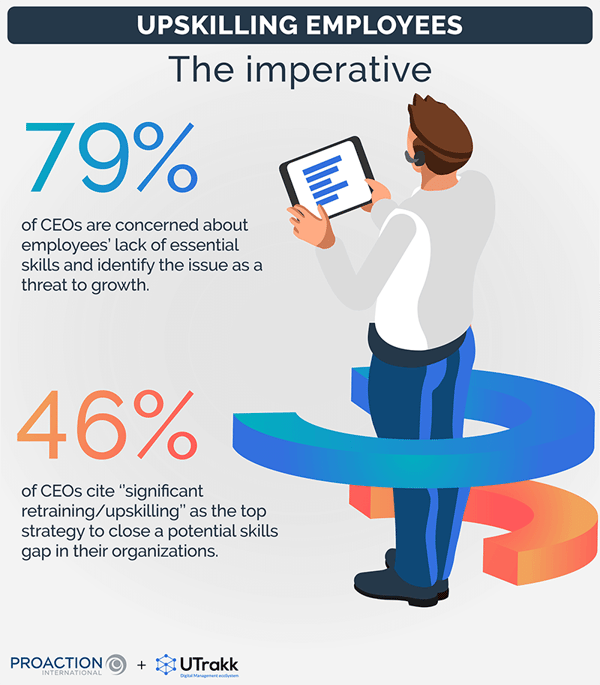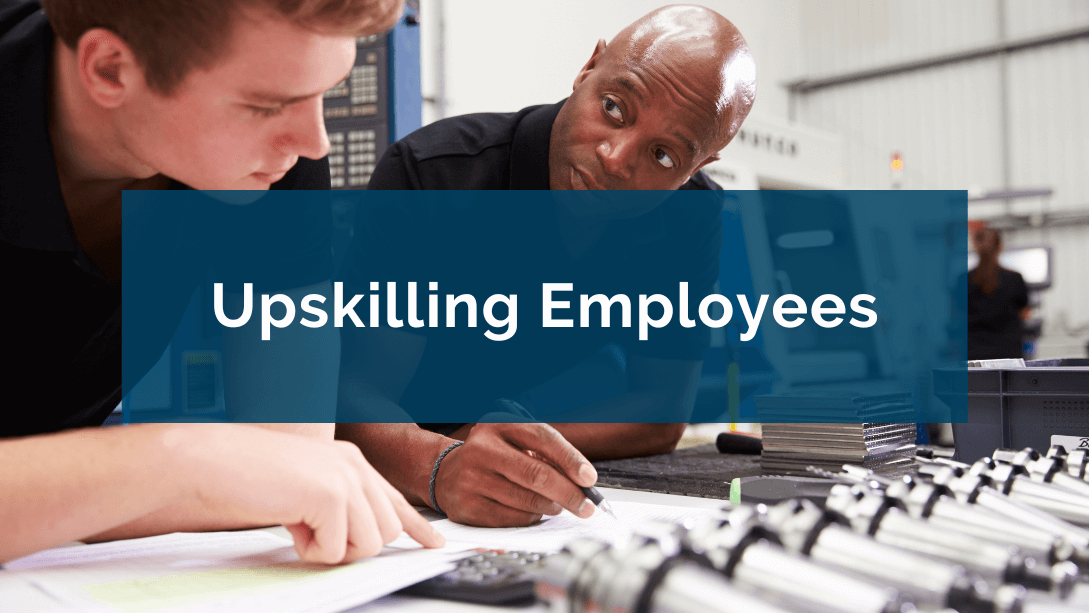Benefits of upskilling employees
Are you still wondering why you should invest in developing your employees' skills? These arguments should convince you:
 Source: SHRM
Source: SHRM
Bridge skill gaps
As a company, you need a skilled workforce to remain competitive and innovative. However, as technologies and working methods evolve, skills gaps can arise. Training employees helps to bridge these gaps, ensuring that they remain effective and relevant in their roles.
Improve employee motivation, satisfaction, and productivity
For workers, having professional growth opportunities is rewarding and highly motivating. Those who benefit from training, coaching and other upskilling methods are more satisfied, and therefore more productive, leading to better customer satisfaction.
In the Randstad 2022 Workmonitor study, 76% of workers worldwide believe that development training programs are important for their future careers. What's more, 53% of workers want to use their newly-acquired skills and experience to grow in their current job. This is good news for employers.
Increase employee engagement and loyalty
Satisfaction and well-being impact not only productivity, but also employee retention. Simply put, skills development decreases employee turnover. It is a key factor in retaining top talent, as workers are more likely to stay with a company that invests in their development, and therefore believes in them.
Attract new talent
Although it's generally more cost-effective to upgrade the skills of your current workforce than to recruit new ones, there are times when you still need to hire.
In such cases, an organization known for encouraging its employees to develop new skills is always more attractive to applicants. It will often be perceived as an employer of choice, and will attract high-caliber candidates on the job market.
Millennials and Generation Z are no longer pursuing job satisfaction; they are pursuing development.
Gallup, It's the Manager
Gain a competitive advantage
A skilled workforce is able to innovate and adapt more quickly to the latest industry trends and new technologies. It's a valuable asset that enables you to stay one step ahead in your sector and maintain a high level of competitiveness.
Employee skills needed in manufacturing for Industry 5.0
Technical skills or STEM (Science, Technology, Engineering, Mathematics)
These skills are fundamental to understanding and working with advanced technologies.
- Technological and digital skills: Understanding of automated systems, robotics, artificial intelligence (AI), the Internet of Things (IoT) and data management software.
- Mechanical engineering and design: Ability to design, operate and maintain complex equipment.
- Data analysis and big data: Skills in analyzing large quantities of data to optimize production processes.
Soft skills
Soft skills are becoming essential in an environment where man-machine collaboration is becoming increasingly important.
- Problem-solving
- Creativity and innovation
- Flexibility
- Communication and collaboration
- Project management, leadership and team management
- Ecological awareness, ethics and social responsibility
- Knowledge of safety and regulatory compliance
As Industry 5.0 draws closer, these skills become increasingly interconnected, requiring professionals able to combine technical expertise with interpersonal and management skills.
8 Strategies to upskill employees

1. Conduct a skill gap analysis
Performing a skills gap analysis enables you to identify the gap between your employees' current skills and those needed to achieve your objectives. It's therefore an excellent way for you to understand where and how to invest in your employees' development.
Here are the key steps:
- Identify skills required for different roles within the company, taking into account current and future developments in the sector.
- Assess employees' current skills.
- Identify gaps in employees' skills to pinpoint any shortcomings or training needs.
- Plan actions to fill skill gaps.
2. Create personalized employee development plans
The idea is to design a customized upskilling program for each employee, based on his or her specific needs, current skills, and career goals.
Here are the key steps:
- Personal assessment, identifying each employee's skills, strengths and areas for improvement.
- Definition of clear, achievable development objectives in line with the employee's career aspirations and the company's needs.
- Selection of the most appropriate training methods for the employee.
- Creation of an action plan with a precise timetable and regular monitoring to measure progress and adjust the plan if necessary.
3. Dedicate time for learning new skills
Allocate specific periods during which workers can devote themselves to their professional development without interfering with their day-to-day responsibilities. This can take the form of dedicated hours during the working day, full days set aside for training, or periods set aside on a regular basis for learning.
This upskilling strategy is a good way of showing that you are fully committed to your employees' development.
4. Provide flexible employee training methods
Training and development opportunities have to be available and accessible to everyone. You have to adapt to your workers' individual needs and possibilities by offering them several training options.
- Mentoring: Pairs a less experienced employee with a more experienced mentor for knowledge transfer and personalized coaching. Benefit: Practical initiation in a real-life work context.
- e-Learning: Provides access to online courses and learning resources via the Internet. Benefit: Great flexibility in terms of time and place for learning.
- Role-playing: Simulates realistic business scenarios where current employees practice skills such as communication and decision-making. Benefit: experiential learning.
- Group activities: Promotes teamwork and collaboration through group projects or challenges. Benefit: Interactive learning and knowledge sharing.
- Video training: Uses video content to present information or skills in an engaging, visual way. Benefit: Self-paced learning.
- Cross-training: Offers employees the opportunity to learn the tasks and responsibilities of other positions. Benefit: Versatility and global understanding of company operations.
- Thematic workshops: Targeted training sessions on specific topics. Benefit: Development of knowledge in specific areas.
- Webinars and online conferences: Participation in online events hosted by industry experts. Benefit: Insight and up-to-date knowledge.
5. Leverage coaching and leadership development expertise from a consulting firm
This strategy involves calling on external experts such as Proaction International to provide specialized training and development for your leaders. It offers several key benefits:
- Consultants bring specialized knowledge and skills in specific fields.
- These experts offer fresh, neutral views. They can therefore identify issues or opportunities that in-house staff may not see.
- This type of company can offer customized training and upskilling programs that meet your specific needs and those of your employees.
According to a Human Capital Institute (HCI) and International Coach Federation (ICF) study, 54% of companies that are classified as "highperforming" have a strong coaching culture.
6. Follow up and track progress
Developing your employees' skills also means monitoring their progress and the efforts they make to perfect their knowledge. This means setting up a regular evaluation and feedback system to measure the effectiveness of upskilling initiatives and the evolution of employees' skills. Don't hesitate to readjust the strategy if necessary.
This approach ensures that upskilling efforts remain aligned with your objectives and mission, and contribute effectively to the professional development of your human resources.
7. Provide real opportunities to grow within the organization
Most engagement research shows that learning opportunities, professional development, and career progression are among the top drivers of employee satisfaction.
Create an environment where workers have the opportunity to progress in their careers according to their skills, performance and aspirations.
This involves several things:
- Providing clear career advancement plans that show how your employees can grow within the organization.
- Favoring internal promotion to encourage your employees to develop their skills with a view to taking up more senior positions.
- Offer specific career development plans that prepare workers for future roles within the company.
- Reward employees who show outstanding improvement and performance with opportunities for advancement.
By offering these development opportunities, companies stimulate employee motivation, engagement and loyalty, with a more competent and dedicated workforce.
8. Create a culture of continuous learning
Value continuous learning within your company culture:
- Provide your employees with a stimulating work environment that values, encourages and integrates skills development and the acquisition of new knowledge into daily life.
- Ensure that your managers are able to adopt a manager-coach approach in order to stimulate their teams' professional development.
- Invite your employees to take charge of their personal development plan by actively seeking out upskilling opportunities.
- Offer easy access to training resources (online libraries, courses, webinars, etc.).
- Value and recognize your employees' learning efforts and achievements.
- Encourage the application of new skills and knowledge in their daily work lives.
In addition to all this, business leaders and HR services must also get involved and support learning as a major strategic issue.
Mastering upskilling for a future-ready workforce
A culture of high employee development is the most productive environment for both your business and your employees.
Gallup, It’s the Manager
The advent of Industry 5.0, with its technological advances and emphasis on human-machine collaboration, is forcing a profound redefinition of skills. Upskilling is becoming an essential strategic lever for companies. It plays a key role not only in making up for skills shortages, but also in promoting learning, boosting motivation and employee productivity, while retaining existing talent and attracting new profiles. Mastery of a range of skills, both technical and interpersonal, becomes the foundation on which employees can adapt and excel.
As you can see, skills development is not just about meeting immediate requirements; it's a wise investment in human capital, catalyzing innovation and long-term organizational growth. Valuing employees as our most precious resources, and investing in their ongoing development, are imperative if we are to keep pace with 5.0. It is through this commitment to learning and professional development that companies will be able to fully exploit their potential and forge a flourishing future.









